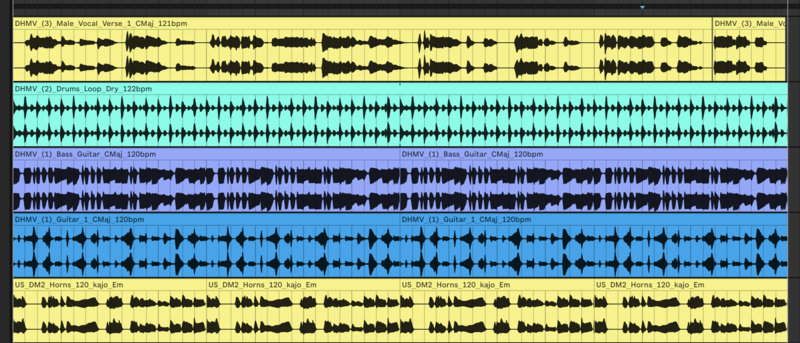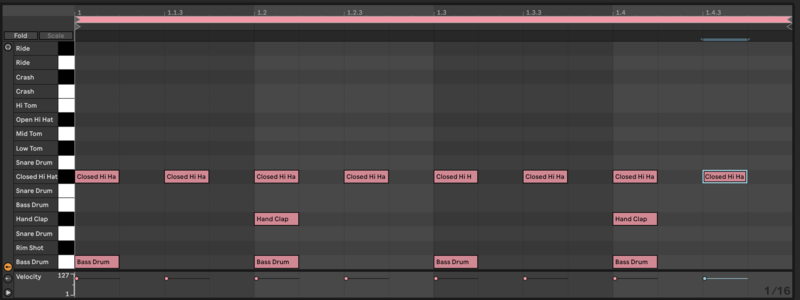Blog
Great Sampling Techniques: Daft Punk's High Life
14 May '2025
Learn how to create and flip disco samples in the style of two of the greatest to ever do it

Sampling has been the backbone of dance music since its inception. So, it’s no surprise that Daft Punk – one of the genre’s most respected and commercially successful acts – have always embraced sampling liberally in their music.
The French production duo’s 2001 album Discovery is packed full of classic samples and ingenious sampling techniques. It's an album that pays homage to the past while pushing the boundaries of what dance music could be in the new millennium.
Daft Punk particularly loved repurposing disco and soul tracks, flipping them into certified dancefloor anthems. Take the album’s two best-loved songs: One More Time and Harder, Better, Faster, Stronger.
One More Time opens with a sliced-up sample of More Spell On You by Eddie Johns – a cover of a 1956 track by Herb Slotkin. Meanwhile, Harder, Better, Faster, Stronger – which would itself be famously sampled by Kanye West on Stronger – is built around the opening bars of Cola Bottle Baby by Edwin Birdsong.
But in this edition of Great Sampling Techniques, we’re turning our focus to the eighth track on Discovery: High Life.
We won’t just explore what samples Daft Punk used on High Life – we’ll also dive into the sampling techniques they employed, showing you how you can use the same ideas to create a fresh beat of your own.
So, read on to discover the great sampling techniques behind Daft Punk’s High Life.
The sample
In classic Daft Punk fashion, the beat of Hard Life is built using samples from a vintage disco track. This time, the production duo turned to American five-piece Tavares.
Tavares – made up of members Pooch, Ralph, Chubby, Butch and Tiny – were active from 1973 to 1986, and released an impressive 12 albums in that time. They’re best known for their 1976 hit Heaven Must Be Missing An Angel, which climbed to number 4 in the UK, reached the top spot in the Dutch charts.
But for High Life, Daft Punk sampled a deeper cut: Break Down For Love from Love Uprising, Tavares’ least successful album – ironic given the commercial success Daft Punk achieved, in part, thanks to their sample.
This sample is a little harder to hear than those of One More Time and Harder, Better, Faster, Stronger, as there’s a little more sample manipulation at play.
Unlike with Harder, Better, Faster, Stronger, where Daft Punk have directly lifted the opening bars from Cola Bottle Baby, to create the beat for High Life, Daft Punk did a lot of chopping, changing, and even repitching of the original material.
So, let’s dive into exactly what they did.
The technique
Daft Punk’s sampling technique on High Life is simple in concept but effective in execution.
Anyone familiar with their work knows they have a distinctive approach to sampling: they typically take a soul or disco song, slice it at each bar or beat, and then reorder the elements to craft an entirely new groove.
That’s exactly what they’ve done on High Life. To create the first bar of the track’s two-bar pattern, they sampled:
- One beat at 1:33 from Break Down for Love,
- One beat at 1:38, and
- Two beats at 0:36.
Then, for the second bar:
- One beat from 1:33,
- One beat from 1:38, and
- Two beats from 0:59.
They didn’t stop at just slicing and rearranging. Daft Punk also sped up the original sample, increasing its tempo to a more dancefloor-friendly BPM. Speeding it up not only enhanced the track’s energy but also raised the pitch, giving the sample a brighter, almost helium-like vocal timbre.
This is particularly notable on the vocals, which sound like they could have been sung by a female vocalist, despite all members of Tavares being men. Pitching up vocals like this is a classic dance music sampling technique.
Want to learn how to recreate another dance music classic? Check out our article Unpacked: Stardust 'Music Sounds Better With You' - Recreated with Loopcloud.
Using the technique
So, let’s have a go at using this sampling technique to build a dance track inspired by Daft Punk’s High Life.
Loopcloud is brimming with quality disco samples that we can use. Because Daft Punk sample full mixdowns from vinyl, we need to layer some disco samples from Loopcloud to build out the feel of a full, recorded track..
Step 1 – Creating an “old-school” disco sample
First, we’ll create a full disco loop using several Loopcloud samples. Packs like TD Audio’s Disco House Vocals are perfect for this. In this sample pack, you’ll find vocal, drums, bass, guitar, and loads of other instruments playing disco loops that are designed to seamlessly fit together.
Here, we’ve found a vocal, drum, guitar and bass part that work well together.
Another key element of the original Tavares sample is the horns. So, we’ve grabbed some disco horns from the excellent Disco Madness 2 by UNDGRND SOUNDS.

Loopcloud tells you what key every sample is in, which makes it very easy to identify samples that will work harmoniously – you can even key lock so loops are automatically repitched to your desired key.
With our mini disco track assembled, it’s time to resample it into a single audio file for chopping. But first, we want it to sound like an old vinyl sample.
We’ll group the tracks together, apply some glue compression, and add a little vinyl saturation and crackle. This will help give the illusion that we’ve found this sample in some dusty bargain bucket of a charity shop or second-hand record store and then recorded it into our DAW.
If you don’t have an effects plugins that can help you get that vinyl crackle and saturation, RC-20 Retro Color by XLN Audio, and Lifeline Console by Excite Audio are two excellent options

Now, we’ll print the group to a new audio track to create our sample for chopping. To do this, create a new audio track, and set the input of the new track to your sample group. Arm the track, and hit record.
Step 2 – Slicing the sample
Now for the fun bit! It’s time to reimagine our disco sample as a dancefloor banger.
First, boost the tempo of your DAW project to 125 BPM to match the tempo of High Life.
We also need to pitch our sample up to recreate the timbre of Daft Punk’s track. Let’s try three semitones.
As discussed, Daft Punk sample sections from Love Uprising in a one beat, one beat, two beat, one beat, one beat, two beat configuration. Each of the two bar sections contains a vocal sample.
The process of finding and rearranging samples is a trial-and-error process. Scan through your full disco sample and identify sections that you think could work, then have a go at arranging them in your timeline. It’s a little like building a sonic LEGO set.
Using our makeshift disco sample, we’ve created a similar pattern to that of High Life. The colours in the image below show how this works.

Now, to fully contextualise our sample flip, let’s add a Daft Punk-style drum beat underneath.
In High Life, Daft Punk opt for a classic, four-to-the-floor house beat, so we’ve done the same, using Roland TR-909 drum samples for some classic house flavour.

In summary
The techniques outlined in this article are specifically inspired by High Life, but the method of reordering and repitching disco samples is one that’s common in all of Daft Punk’s music, and the French house genre as a whole. Artists like Martin Solveig, Bob Sinclar, and David Guetta all use this style of sampling in their tracks.
If you want to learn more about old-school sampling techniques that you can recreate in your DAW, look no further than our article Unlocking Vintage Vibes: Mastering Classic Sampler Techniques in Modern Music Production.

